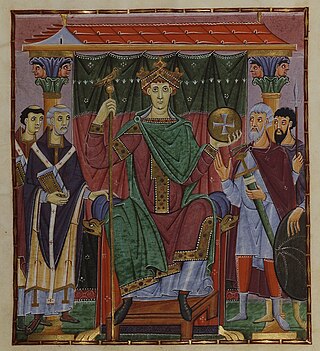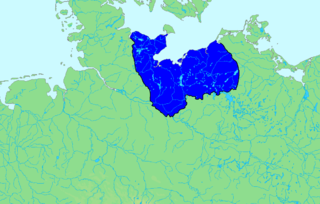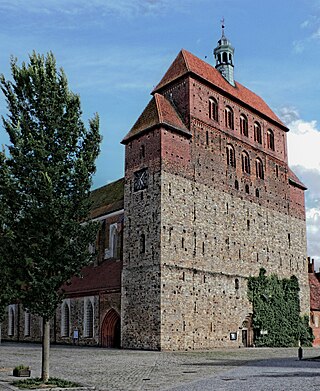
Otto III was the Holy Roman emperor from 996 until his death in 1002. A member of the Ottonian dynasty, Otto III was the only son of Emperor Otto II and his wife Theophanu.

The Obotrites or Obodrites, also spelled Abodrites, were a confederation of medieval West Slavic tribes within the territory of modern Mecklenburg and Holstein in northern Germany. For decades, they were allies of Charlemagne in his wars against the Germanic Saxons and the Slavic Veleti. The Obotrites under Prince Thrasco defeated the Saxons in the Battle of Bornhöved (798). The still-Pagan Saxons were dispersed by the emperor, and the part of their former land in Holstein north of Elbe was awarded to the Obotrites in 804, as a reward for their victory. This however was soon reverted through an invasion of the Danes. The Obotrite regnal style was abolished in 1167, when Pribislav was restored to power by Duke Henry the Lion, as Prince of Mecklenburg, thereby founding the Germanized House of Mecklenburg.

The Altmark is a historic region in Germany, comprising the northern third of Saxony-Anhalt. As the initial territory of the March of Brandenburg, it is sometimes referred to as the "Cradle of Prussia", as by Otto von Bismarck, a native of Schönhausen near Stendal.

The Archbishopric of Magdeburg was a Latin Catholic archdiocese (969–1552) and Prince-Archbishopric (1180–1680) of the Holy Roman Empire centered on the city of Magdeburg on the Elbe River.

The Congress of Gniezno was an amicable meeting between the Polish Duke Bolesław I the Brave and Emperor Otto III, which took place at Gniezno in Poland on 11 March 1000. Scholars disagree over the details of the decisions made at the convention, especially whether the ruler of Poland was pledged the king's crown or not.

The Northern March or North March was created out of the division of the vast Marca Geronis in 965. It initially comprised the northern third of the Marca and was part of the territorial organisation of areas conquered from the Wends. A Lutician rebellion in 983 reversed German control over the region until the establishment of the March of Brandenburg by Albert the Bear in the 12th century.

The Wendish Crusade was a military campaign in 1147, one of the Northern Crusades, led primarily by the Kingdom of Germany within the Holy Roman Empire and directed against the Polabian Slavs. The Wends were made up of the Slavic tribes of Abrotrites, Rani, Liutizians, Wagarians, and Pomeranians who lived east of the River Elbe in present-day northeast Germany and Poland.

Polabian Slavs, also known as Elbe Slavs and more broadly as Wends, is a collective term applied to a number of Lechitic tribes who lived scattered along the Elbe river in what is today eastern Germany. The approximate territory stretched from the Baltic Sea in the north, the Saale and the Limes Saxoniae in the west, the Ore Mountains and the Western Sudetes in the south, and Poland in the east.

The Diocese of Magdeburg is a Latin Church diocese of the Catholic Church, located in the German state of Saxony-Anhalt. Its seat is Magdeburg; it is suffragan to the Archdiocese of Paderborn.

Lebus is a historic town in the Märkisch-Oderland District of Brandenburg, Germany. It is the administrative seat of Amt Lebus. The town, located on the west bank of the Oder river at the border with Poland, was the centre of the historical region known as Lubusz Land, which provides the name for the present-day Polish Lubusz Voivodeship.

The Margravate or Margraviate of Meissen was a medieval principality in the area of the modern German state of Saxony. It originally was a frontier march of the Holy Roman Empire, created out of the vast Marca Geronis in 965. Under the rule of the Wettin dynasty, the margravate finally merged with the former Duchy of Saxe-Wittenberg into the Saxon Electorate by 1423.

The diocese of Brandenburg existed between the 10th and 16th centuries. From the 12th century, its bishops also ruled the Hochstift Brandenburg.
Gisilher, Gisiler or Giseler was the second Archbishop of Magdeburg, succeeding Saint Adalbert, from 981 until his death in 1004.
Dietrichof Haldensleben was a count in the Schwabengau, later also in the Nordthüringgau and the Derlingau, who was the first Margrave of the Northern March from 965 until the Great Slav Rising of 983. He also bore the title of a dux (duke) in contemporary sources.He was a ancestor of John V
Lothair I was Margrave of the Nordmark from about 983 until his death. He was also a member of Saxon nobility as Count of Derlingau and of Nordthüringgau.

The Billung March or March of the Billungs was a frontier region of the far northeastern Duchy of Saxony in the 10th century. It was named after the family which held it, the House of Billung.

The Bishopric of Havelberg was a Roman Catholic diocese founded by King Otto I of Germany in 946, from 968 a suffragan to the Archbishops of Magedeburg. A Prince-bishopric (Hochstift) from 1151, Havelberg as a result of the Protestant Reformation was secularised and finally annexed by the margraves of Brandenburg in 1598.

Pomerania during the Early Middle Ages covers the History of Pomerania from the 7th to the 11th centuries.

The Lutici or Liutizi(known by various spelling variants) were a federation of West Slavic Polabian tribes, who between the 10th and 12th centuries lived in what is now northeastern Germany. Four tribes made up the core of the federation: the Redarians, Circipanians (Circipani), Kessinians and Tollensians (Tholenzi). At least in part, the Lutici were a continuation of the Veleti. In contrast to the former and the neighboring peoples, the Lutici were not led by a Christian monarch or duke, rather power was asserted through consensus formed in central assemblies of the social elites, and the Lutici worshipped nature and several deities. The political and religious center was Radgosc.

Mistislaw, also known as Mstislav, was an Elbe Slavic prince of the Nakonid lineage and ruled over the Obotrites in what is now Mecklenburg and eastern Holstein from 990/995 to 1018.

















